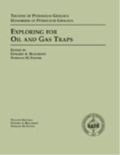Trap leakage
Jump to navigation
Jump to search
| Exploring for Oil and Gas Traps | |

| |
| Series | Treatise in Petroleum Geology |
|---|---|
| Part | Predicting the occurrence of oil and gas traps |
| Chapter | Predicting preservation and destruction of accumulations |
| Author | Alton A. Brown |
| Link | Web page |
| Store | AAPG Store |
Leakage occurs when petroleum escapes a trap through the sealing lithology. Escape of petroleum up a fault which cuts the sealing lithology is also leakage. Leakage along faults can occur by the same mechanisms which control leakage through top seals.
Five major seal failure mechanisms form the basis for this section's discussion on seal leakage.
Seal failure mechanisms
A given seal can leak by one of several mechanisms, as defined by Watts.[1] The first three mechanisms listed have minimum pressure criteria to be exceeded before leakage occurs. Even after leakage, an economic column of petroleum may remain. The last two mechanisms can destroy an accumulation, given enough time. Follow the links for more details:
| Seal Type | Seal Failure Mechanism |
|---|---|
| Intact membrane | Capillary pressure (created by the height of the underlying petroleum column) exceeds seal capillary displacement pressure. This seal type does not fracture during deformation. |
| Fractured membrane | Capillary pressure exceeds displacement pressure of fracture porosity in the seal. |
| Hydrofractured | Total fluid pressure (capillary pressure plus water pressure) exceeds minimum compressive stress of the seal; seal fails by natural hydraulic fracturing. |
| Micropermeability | Leakage is caused by low displacement pressures of oil-wet seals or by capillary pressure of the reservoir exceeding displacement pressure of the seal in a water-wet seal. Accumulations are preserved for geologically significant time if leakage rate is low. Rate of leakage is controlled by seal effective permeability. |
| Diffusive | Gas is lost by dissolving in water and diffusing through interstitial water of the seal. |
See also
References
- ↑ Watts, N., L., 1987, Theoretical aspects of cap-rock and fault seals for single- and two-phase hydrocarbon columns: Marine and Petroleum Geology, vol. 4, p. 274–307., 10., 1016/0264-8172(87)90008-0